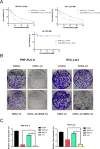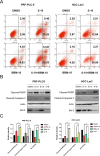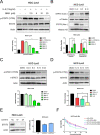Berbamine (BBM), a Natural STAT3 Inhibitor, Synergistically Enhances the Antigrowth and Proapoptotic Effects of Sorafenib on Hepatocellular Carcinoma Cells
- PMID: 33015502
- PMCID: PMC7528295
- DOI: 10.1021/acsomega.0c03527
Berbamine (BBM), a Natural STAT3 Inhibitor, Synergistically Enhances the Antigrowth and Proapoptotic Effects of Sorafenib on Hepatocellular Carcinoma Cells
Abstract
Sorafenib (SORA), a multi kinase inhibitor, is the standard first-line targeted therapy approved by the Food and Drug Administration for advanced hepatocellular carcinoma (HCC). However, emerging evidence from clinical practice indicates that SORA alone has only moderate antitumor effects and could not completely inhibit the progression of the disease. Therefore, it is very necessary and urgent to develop novel combination therapy to improve the clinical outcomes of SORA. The pharmacological study on the chemosensitizing effects of natural products has become a hotspot in recent years, which is commonly thought to be a potential way to improve the effectiveness of drugs in clinical use. Berbamine (BBM) has potential sensitizing effects in multiple chemotherapies and target therapy. However, it remains unclarified whether the combination of BBM and SORA as a treatment could exert a synergistic effect on HCC cell lines. In this study, we first investigated whether BBM can increase the sensitivity of HCC cell lines to SORA. The results revealed that the combination of BBM and SORA could synergistically inhibit the growth of two HCC cell lines and promoted their apoptosis. Mechanistically, our results showed that BBM exerted a dose-dependent inhibitory effect on the basal and IL-6-induced STAT3 activation of HCC cell lines. In addition, the combined treatment of BBM and SORA synergistically suppressed STAT3 phosphorylation at Tyr705 and knockdown of STAT3 abolished the sensitization effect of BBM, indicating that BBM's sensitization effect is mainly mediated by its inhibition of STAT3. These findings identify a new type of natural STAT3 inhibitor and provide a novel approach to the enhancement of SORA efficacy by blocking the activation of STAT3.
Conflict of interest statement
The authors declare no competing financial interest.
Figures





Similar articles
-
Berbamine Enhances the Efficacy of Gefitinib by Suppressing STAT3 Signaling in Pancreatic Cancer Cells.Onco Targets Ther. 2019 Dec 24;12:11437-11451. doi: 10.2147/OTT.S223242. eCollection 2019. Onco Targets Ther. 2019. PMID: 31920333 Free PMC article.
-
Sequence‑dependent effect of sorafenib in combination with natural phenolic compounds on hepatic cancer cells and the possible mechanism of action.Int J Mol Med. 2018 Sep;42(3):1695-1715. doi: 10.3892/ijmm.2018.3725. Epub 2018 Jun 8. Int J Mol Med. 2018. PMID: 29901131 Free PMC article.
-
Norcantharidin potentiates sorafenib antitumor activity in hepatocellular carcinoma rat model through inhibiting IL-6/STAT3 pathway.Transl Res. 2023 Oct;260:69-82. doi: 10.1016/j.trsl.2023.05.005. Epub 2023 May 30. Transl Res. 2023. PMID: 37257560
-
AG-1024 Sensitizes Sorafenib-Resistant Hepatocellular Carcinoma Cells to Sorafenib via Enhancing G1/S Arrest.Onco Targets Ther. 2021 Feb 15;14:1049-1059. doi: 10.2147/OTT.S289324. eCollection 2021. Onco Targets Ther. 2021. PMID: 33623392 Free PMC article.
-
Hepatocellular Carcinoma: Etiology and Current and Future Drugs.J Clin Exp Hepatol. 2019 Mar-Apr;9(2):221-232. doi: 10.1016/j.jceh.2019.01.004. Epub 2019 Jan 25. J Clin Exp Hepatol. 2019. PMID: 31024205 Free PMC article. Review.
Cited by
-
Potassium channels as novel molecular targets in hepatocellular carcinoma (Review).Oncol Rep. 2023 Oct;50(4):185. doi: 10.3892/or.2023.8622. Epub 2023 Sep 1. Oncol Rep. 2023. PMID: 37654193 Free PMC article. Review.
-
A culture method with berbamine, a plant alkaloid, enhances CAR-T cell efficacy through modulating cellular metabolism.Commun Biol. 2024 Jun 4;7(1):685. doi: 10.1038/s42003-024-06297-0. Commun Biol. 2024. PMID: 38834758 Free PMC article.
-
Phloretin, as a Potent Anticancer Compound: From Chemistry to Cellular Interactions.Molecules. 2022 Dec 12;27(24):8819. doi: 10.3390/molecules27248819. Molecules. 2022. PMID: 36557950 Free PMC article. Review.
-
Therapeutic effects of TM4SF5-targeting chimeric and humanized monoclonal antibodies in hepatocellular and colon cancer models.Mol Ther Oncolytics. 2022 Jan 31;24:452-466. doi: 10.1016/j.omto.2022.01.006. eCollection 2022 Mar 17. Mol Ther Oncolytics. 2022. PMID: 35211652 Free PMC article.
-
Berbamine Suppresses the Growth of Gastric Cancer Cells by Inactivating the BRD4/c-MYC Signaling Pathway.Drug Des Devel Ther. 2022 Jan 11;16:129-141. doi: 10.2147/DDDT.S338881. eCollection 2022. Drug Des Devel Ther. 2022. PMID: 35046638 Free PMC article.
References
LinkOut - more resources
Full Text Sources
Molecular Biology Databases
Miscellaneous

